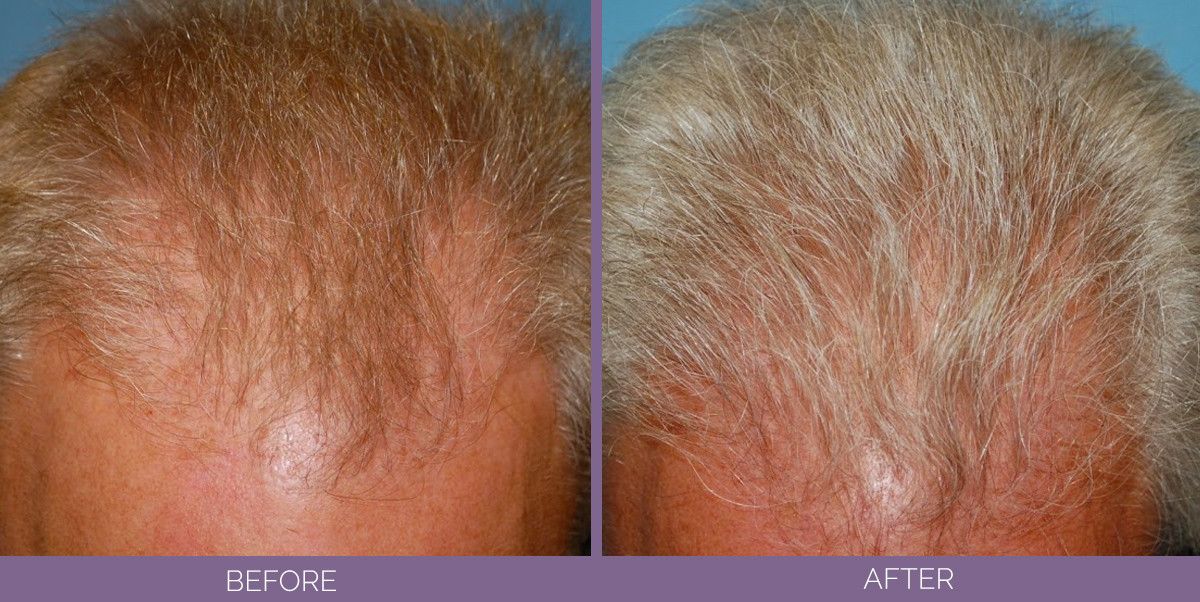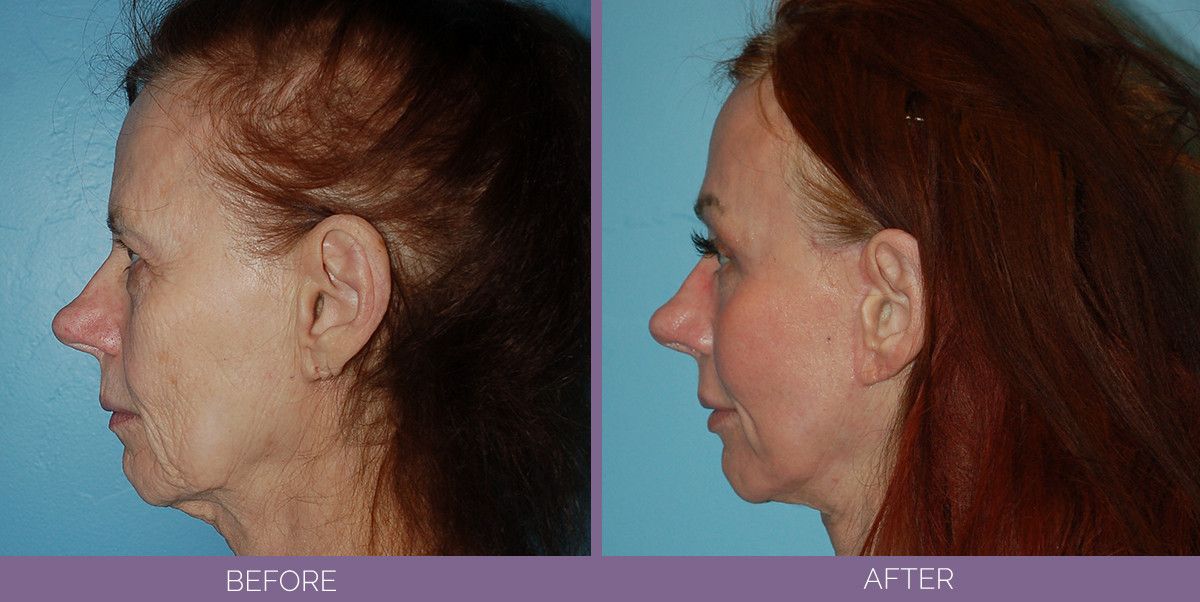Hair Transplant Surgery
Reverse the aging process. Fast recovery with outstanding results.
A Permanent Solution to Hair Loss
Choosing to have hair restoration surgery (HRS) is a major decision for most people. HRS will permanently change your appearance to a more youthful look. A balding man rarely conjures up the image of youth and vitality and that is what most modern men are striving for today. For men who have not lost their hair, this information will be of little value. But for those men suffering from hair loss who want their hair restored, HRS is the only permanent solution available for men today for hair replacement. HRS will restore hair that will grow naturally and require styling and haircuts, just like men who do not suffer from hair loss.
The first consultation with your hair restoration surgeon is critical to success. A frank discussion of goals and treatment plans goes a long way to achieving satisfying results.
The surgical treatment of hair loss can be broadly divided into three main areas: hair transplantation, scalp reduction, and scalp flaps.
Before and After Photos


Testimonials from Real Patients


K. Pinkston
Dr.Vincent is the most kind, meticulous and skilled cosmetic surgeon in Utah. He goes way beyond what any other doctor would do, sometimes with no fee, in order to create the most perfect version of his patients. His perfectionism shows in the quality of his work. #drakevincentrealisticallyamazing


Allison T.
After going to multiple consultations, I finally decided to go with Vincent Surgical Arts and couldn’t be more satisfied with my results. The staff go above and beyond to ensure that I am comfortable and taken care of. My results are better than expected. If you want quality results at a good price, schedule a consultation today, you’ll be glad you did!
Why Choose Vincent Surgical Arts?
Fast Recovery
Advanced techniques result in less down time
Lasting Results
Enjoy your new beauty for years to come
Financing Available
Our partners have flexible plans with as low as 0% APR
Small Incision
To reduce recovery time and scarring
Less Scaring
Thanks to talented surgeons with decades of experience
Request a Consultation
Get all your questions answered. Schedule an appointment!
Frequently Asked Questions
What is a hair transplant?
Hair transplantation is an operation which takes hair from the back of the head and moves it to the area of hair loss. The fringe (back and sides) of hair on a balding scalp is known as donor dominant hair which is the hair that will continue to grow throughout the life of most men. The transplantation of this hair to a bald area does not change its ability to grow. Donor dominance is the scientific basis for the success of hair transplantation.
Candidates for HRS are those individuals with hair loss that have sufficient donor hair from the fringe of the scalp to transplant to the balding area. In the past, many bald patients were not suitable candidates for HRS but modern techniques have advanced the art of HRS so that many more men are candidates.
Hair transplantation surgery has improved by leaps and bounds over the past decade. The days of the “plugs and corn rows” are gone and the age of single hair, micro and mini-grafting have arrived. Through the use of these variable-sized hair grafts, along with new and improved instrumentation, the accomplished hair transplant surgeons can create a natural hair appearance that is appropriate for each individual patient. Single-hair grafts have the finest and softest appearance. Although they do not provide much density, they do provide the critical soft hairline that is the transition to thicker hair. Reconstructing a new hairline is a skill requiring surgical as well as artistic skill. It is critically important to get it right the first time and thus requires considerable forethought and planning. Examining the hairline of a non-balding person will show the presence of numerous single hairs in the very frontal hairline. Micro-grafts are small grafts containing two to three hairs that are placed behind the hairline to provide a gradually increasing hair density. Lastly, mini-grafts contain four or more hairs and are placed well behind the hairline so that the single hair and micro-grafts can blend naturally into the density provided by these larger grafts.
There are different terminology and techniques used by many surgeons. New techniques naturally give rise to new terms. Although there are variations in the techniques of individual surgeons, the combination use of these grafting techniques provides the most natural and pleasing results.
The side effects of hair transplantation surgery are relatively minor consisting of mild pain and discomfort after the operation, swelling which may move down to the eyes, and the formation of scabs over the grafts which take approximately one week to resolve. Serious problems of bleeding, scarring, and infection are rare. Modern hair transplantation surgery is comfortable, predictable, and the results are pleasing to most patients.
Hair loss, however, is a life-long process. Most men will develop male pattern baldness (due to male hormones) until approximately 40-45 years of age. After that, the aging process thins the entire head of hair. Progressive hair loss, or the desire for more density, will require more transplant procedures. Modern techniques, however, allow HRS specialists to transplant a larger number of grafts, greatly reducing the number of procedures needed to complete the result.
Why do we lose hair?
Though humans no longer make use of hair for protection, heat retention, or camouflage, it still remains a very important means by which individuals display and are recognized. Appropriate appearance and grooming are still very important in social organizations and in human relationships. The human body contains approximately five million hair follicles while the scalp (prior to any kind of hair loss) contains 100,000-150,000 hair follicles. Blondes have the greatest number of scalp follicles, followed by brunettes. Those individuals with red hair have the fewest number of scalp follicles. The normal growth rate of scalp hair is one-fourth to one-half inch per month.
The Normal Hair Growth Cycle
It is important to understand the normal hair growth cycle to understand why hair loss occurs. The hair follicle is an anatomical structure which evolved to produce and extrude (push out) a hair shaft. Hair is made up of proteins called keratins. Human hair grows in a continuous cyclic pattern of growth and rest known as the “hair growth cycle.” Three phases of the cycle exist: Anagen: growth phase; Catagen: degradation phase; Telogen: resting phase. Periods of growth (anagen) between two and eight years are followed by a brief period, two to four weeks, in which the follicle is almost totally degraded (catagen). The resting phase (telogen) then begins and lasts two to four months. Shedding of the hair occurs only after the next growth cycle (anagen) begins and a new hair shaft begins to emerge. On average, 50-100 telogen hairs are shed every day. This is normal hair loss and accounts for the hair loss seen every day in the shower and with hair combing. These hairs will regrow. Not more than ten percent of the follicles are in the resting phase (telogen) at any time. A variety of factors can affect the hair growth cycle and cause temporary or permanent hair loss (alopecia) including medication, radiation, chemotherapy, exposure to chemicals, hormonal and nutritional factors, thyroid disease, generalized or local skin disease, and stress.
Androgens (testosterone, dihydrotestosterone) are the most important control factors of human hair growth. Androgens must be present for the growth of beard, axillary (underarm), and pubic hair. The growth of scalp hair is NOT androgen-dependent but androgens are necessary for the development of male and female pattern hair loss.
Male Pattern Hair Loss
It is estimated that 35 million men in the United States are affected by androgenetic alopecia. “Andro” refers to the androgens (testosterone, dihydrotestosterone) necessary to produce male pattern hair loss (MPHL). “Genetic” refers to the inherited gene necessary for MPHL to occur. In men who develop MPHL the hair loss may begin any time after puberty when blood levels of androgens rise. The first change is usually recession in the temporal areas, which is seen in 96 percent of mature Caucasian males, including those men not destined to progress to further hair loss. Although the density of hair in a given pattern of loss tends to diminish with age, there is no way to predict what pattern of hair loss a young man with early MPHL will eventually assume. In general, those who begin losing hair in the second decade are those in whom the hair loss will be the most severe. In some men, initial male pattern hair loss may be delayed until the late third to fourth decade. It is generally recognized that men in their 20\92s have a 20 percent incidence of MPHL, in their 30\92s a 30 percent incidence of MPHL, in their 40\92s a 40 percent incidence of MPLH, etc. Using these numbers one can see that a male in his 90\92s has a 90 percent chance of having some degree of MPHL.
Androgens (testosterone, dihydrotestosterone) are necessary for the development of MPHL. The amount of androgens present does not need to be greater than normal for MPHL to occur. If androgens are present in normal amounts and the gene for hair loss is present, male pattern hair loss will occur. Axillary (under arm) and pubic hair are dependent on testosterone for growth. Beard growth and male pattern hair loss are dependent on dihydrotestosterone (DHT). Testosterone is converted to DHT by the enzyme, 5-reductase. Finasteride (Propecia\AE) acts by blocking this enzyme and decreasing the amount of DHT. Receptors exist on cells that bind androgens. These receptors have the greatest affinity for DHT followed by testosterone, estrogen, and progesterone. After binding to the receptor, DHT goes into the cell and interacts with the nucleus of the cell altering the production of protein by the DNA in the nucleus of the cell. Ultimately, growth of the hair follicle ceases.
The hair growth cycle is affected in that the percentage of hairs in the growth phase (anagen) and the duration of the growth phase diminish resulting in shorter hairs. More hairs are in the resting state (telogen) and these hairs are much more subject to losS with the daily trauma of combing and washing. The hair shafts in MPHL become progressively miniaturized (smaller in diameter and length) with time. In men with MPHL all the hairs in an affected area may eventually (but not necessarily) become involved in the process and may, with time, cover the region with fine (vellus) hair. Pigment (color) production is also terminated with miniaturization so the fine hair becomes lighter in color. The lighter-colored miniaturized hairs cause the area to first appear thin. Involved areas in men can completely lose all follicles over time. MPHL is an inherited condition and the gene can be inherited from either the mother or father\92s side. There is a common myth that inheritance is only from the mother\92s side. This is not true.
In summary, male pattern hair loss (Androgenetic Alopecia) is an inherited condition manifested when androgens are present in normal amounts. The gene can be inherited from the mother or father\92s side. The onset, rate, and severity of hair loss are unpredictable. The severity increases with age and if the condition is present it will be progressive and relentless.
Female Pattern Hair Loss
Female hair loss occurs in more than one pattern.
If you are a woman with loss of scalp hair, you should seek professional advice from a physician hair restoration specialist.
In most cases, female hair loss can be effectively treated.
If you are a woman who has started to lose scalp hair, you are not alone if:
1. You are unpleasantly surprised by the hair loss, and
2. You don’t understand why you are losing hair.
The patterns of hair loss in women are not as easily recognizable as those in men.
Hair loss in men is likely to occur primarily between late teenage years and age 40-50 in a generally recognizable “male pattern” baldness known as androgenetic alopecia. Men with male pattern hair loss may have an expectation of hair loss if they have male relatives who lost hair in a recognizably male pattern.
Unlike hair loss in men, female scalp hair loss may commonly begin at any age through 50 or later, may not have any obvious hereditary association, and may not occur in a recognizable “female pattern alopecia” of diffuse thinning over the top of the scalp. A woman who notices the beginning of hair loss may not be sure if the loss is going to be temporary or permanent: For example, if there has been a recent event such as pregnancy or illness that may be associated with temporary hair thinning. If you are a woman who is worried about loss of scalp hair, you should consult a physician hair restoration specialist for an evaluation and diagnosis.
Self-diagnosis is often ineffective. Women tend to have less obvious patterns of hair loss than men, and non-pattern types of hair loss are more frequent in women than in men. Diagnosis of hair loss in a woman should be made by a trained and experienced physician.
In women, as in men, the most likely cause of scalp hair loss is androgenetic alopecia, an inherited sensitivity to the effects of androgens (male hormones) on scalp hair follicles. However, women with hair loss due to this cause usually do not develop true baldness in the patterns that occur in men. For example, women rarely develop the “cue-ball” appearance often seen in male pattern androgenetic alopecia.
Patterns of female androgenetic alopecia can vary considerably in appearance.
Patterns that may occur include:
Diffuse thinning of hair over the entire scalp, often with more noticeable thinning toward the back of the scalp.
Diffuse thinning over the entire scalp, with more noticeable thinning toward the front of the scalp but not involving the frontal hairline.
Diffuse thinning over the entire scalp, with more noticeable thinning toward the front of the scalp, involving and sometimes breaching the frontal hairline.
Unlike the case for men, thinning scalp hair in women due to androgenetic alopecia does not uniformly grow smaller in diameter (miniaturize). Women with hair loss due to androgenetic alopecia tend to have miniaturizing hairs of variable diameter over all affected areas of the scalp. While miniaturizing hairs are a feature of androgenetic alopecia, miniaturization may also be associated with other causes and is not in itself a diagnostic feature of androgenetic alopecia. In post-menopausal women, for example, hair may begin to miniaturize and become difficult to style. The precise diagnosis should be made by a physician hair restoration specialist.
It is important to note that female pattern hair loss can begin as early as the late teens to early 20s in women who have experienced early puberty. If left untreated, this hair loss associated with early puberty can progress to more advanced hair loss.
NON PATTERN CAUSES OF HAIR LOSS IN WOMEN
In women, more often than in men, hair loss may be due to conditions other than androgenetic alopecia. Some of the most common of these causes are:
Trichotillomania — compulsive hair pulling. Hair loss due to trichotillomania is typically patchy, as compulsive hair pullers tend to concentrate the pulling in selected areas. Hair loss due to this cause cannot be treated effectively until the psychological or emotional reasons for trichotillomania are effectively addressed.
Alopecia areata — a possibly autoimmune disorder that causes patchy hair loss that can ranges from diffuse thinning to extensive areas of baldness with “islands” of retained hair. Medical examination is necessary to establish a diagnosis.
Triangular alopecia — loss of hair in the temporal areas that sometimes begins in childhood. Hair loss may be complete, or a few fine, thin-diameter hairs may remain. The cause of triangular alopecia is not known, but the condition can be treated medically or surgically.
Scarring alopecia —hair loss due to scarring of the scalp area. Scarring alopecia typically involves the top of the scalp and occurs predominantly in women. The condition frequently occurs in African-American women and is believed to be associated with persistent tight braiding or “corn-rowing” of scalp hair. A form of scarring alopecia also may occur in post-menopausal women, associated with inflammation of hair follicles and subsequent scarring.
Telogen effluvium — a common type of hair loss caused when a large percentage of scalp hairs are shifted into “shedding” phase. The causes of telogen effluvium may be hormonal, nutritional, drug-associated, or stress-associated.
Loose-anagen syndrome — a condition occurring primarily in fair-haired persons in which scalp hair sits loosely in hair follicles and is easily extracted by combing or pulling. The condition may appear in childhood, and may improve as the person ages.
Is There a Non-Surgical Option for Hair Restoration?
Only two hair restoration medications have been approved by the FDA after testing for safety and efficacy in clinical trials. These are the topical medication minoxidil (Rogaine\AE) and the orally administered prescription medication finasteride (Propecia\AE). Safety and efficacy information for these medications is clearly stated, as required by the FDA in product information provided with the product. Neither product \93guarantees\94 to stop hair loss or stimulate the growth of new hair because hair loss can be due to many causes that may or may not be treatable by the medications. Finasteride (Propecia\AE) is available only by prescription from a physician. While minoxidil (Rogaine\AE) is available as an over-the-counter topical medication, both finasteride and minoxidil are most effective when used as recommended by a physician hair restoration specialist after the cause of hair loss is correctly diagnosed.
Contact Us Today

6710 Blackstone Rd #201, Cottonwood Heights, UT 84121
